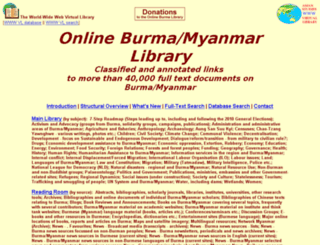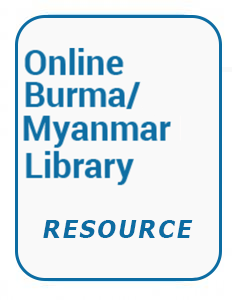Focal point
Location
The Online Burma/Myanmar Library (OBL) is a non-profit online research library mainly in English and Burmese serving academics, activists, diplomats, NGOs, CSOs, CBOs and other Burmese and international actors. It is also, of course, open to the general public. Though we provide lists of Burma/Myanmar news sources, the Library’s main content is not news but in-depth articles, reports, laws, videos and links to other websites, We provide a search engine (database and full text) and an alphabetical list of categories and sub-categories, but the Library is best accessed through browsing the 100 or so categories which lead to sub- and sub-sub categories. These tools should be used in combination.
Members:
Resources
Displaying 616 - 620 of 1151Myanmar Protected Areas: Context, Current Status and Challenges
... Protected areas (PAs) are important tools for biodiversity conservation and sustainable development. PAs safeguard ecosystems and their services, such as water provision, food production, carbon sequestration and climate regulation, thus improving people’s livelihoods. They preserve the integrity of spiritual and cultural values placed by indigenous people on wild areas and offer opportunities of inspiration, study and recreation.
Myanmar/Burma - The World's Least Known Landmine Tragedy
15 images of landmine victims..."Myanmar, or Burma, is home to one of the world's longest running civil wars. Conflict has occurred since the country gained independence in 1947.
Mine warfare has been a feature of the conflict throughout that time.
Mines are thought to be used by all parties to the conflict. No one knows how many people have been killed or maimed by mines.
This photo exhibit provides a glimpse into the lives of a few of those who survived their mine injury and now live tenuous lives near the border with Thailand..."
Land Tenure: A foundation for food security in Myanmar’s uplands (Burmese/ မြန်မာဘာသာ )
Access to land for smallholder farmers is a critical foundation for food security in Myanmar's uplands. Land tenure guarantees seem to be eroding and access to land becoming more difficult in some upland areas. If this trend continues it may have negative impacts for food security and undermine environmental and economic sustainability. This briefing paper explores the relationship between land tenure and food security, as well as key institutional and other factors that influence land access and tenure for smallholder farmers in the uplands today...
Land Tenure: A foundation for food security in Myanmar’s uplands (English)
Access to land for smallholder farmers is a critical foundation for food security in Myanmar's uplands. Land tenure guarantees seem to be eroding and access to land becoming more difficult in some upland areas. If this trend continues it may have negative impacts for food security and undermine environmental and economic sustainability. This briefing paper explores the relationship between land tenure and food security, as well as key institutional and other factors that influence land access and tenure for smallholder farmers in the uplands today.
Save our Mountain Save our Future -- an update from Burma’s largest iron mine
Pinpet Mountain under imminent threat
as iron project speeds ahead....
"Excavation of Burma’s second largest iron deposit located
in southern Shan State is imminent as bulldozers begin
preparatory clearing on the iconic Pinpet Mountain, home
to 7,000 people. The 300 residents in Pang Ngo village are
in immediate danger from falling rocks and landslides as
machines uproot trees, clear brush and remove top soil on
the west side of the mountain. Farm fi elds at the foot of the
mountain may be covered with toxic waste soils once the


